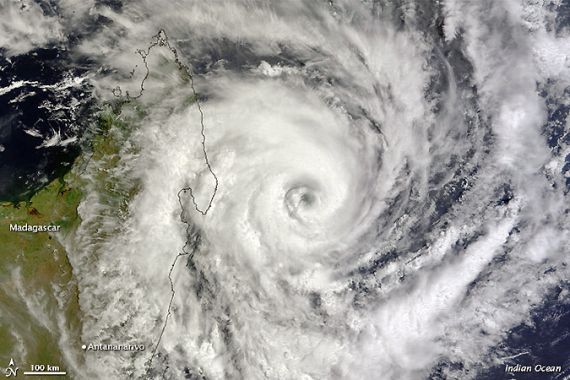Storm season picking up
Australia’s Cyclone season, and that of the Southwest Indian Ocean, have taken a turn for the worse.

 |
| In the last 24 hours, Madagascar was struck by Tropical Cyclone Binginza, for the second time [NASA] |
Australia’s Cyclone season, and that of the Southwest Indian Ocean, both run from October to May. For the first few months things were fairly subdued, but just in the last week things have taken a turn for the worse.
In the last 24 hours, Madagascar was struck by Tropical Cyclone Binginza, for the second time. When it hit the north of the island, Bingiza was the equivalent of a Category 3 hurricane on the Saffir-Simpson Scale.
Keep reading
list of 4 itemsAfter the Hurricane
World’s coral reefs face global bleaching crisis
Why is Germany maintaining economic ties with China?
As it moved across land, it disintegrated, but then it hovered just off the western coast, re-intensifying for round two. It smacked into the island again around 18GMT on Thursday, this time crossing the south of the country.
Although the system has now largely disintegrated, over the next 48 hours, there is still expected to be torrential rain in the northeastern parts of Madagascar, as well as the southeast. These 2 areas are likely to see more flooding and landslides.
There is cause for some relief in Madagascar. However, in the last few hours, another storm has developed in the Southwest Indian Ocean, in the very same region gave rise to Binginza.
Fortunately this last storm appears to be moving south and not towards Madagascar, so the island should escape. Madagascar is one of the poorest countries in the world, so it would find it very difficult to recover from two storms in such close proximity.
Cyclone Dianne raging
The other Tropical Cyclones are in Australasia.
Former Tropical Cyclone Carlos is now decaying over northern Australia. After dumping 644mm rain over Darwin between Tuesday and Thursday, the rain appears to be easing. By no means will it be dry in Darwin, but the worst appears to be over.
Tropical Cyclone Dianne is still raging just off the coast of Western Australia. It’s staying away from land for the time being, but the outer fringes are going to bring torrential rain to the state and as the ground here is baked dry, this is likely to cause widespread flooding.
There is also one more storm which is developing, it has recently been named as Tropical Cyclone Atu. This one is situated to the east of Australia, about 360km northeast of Port Vila in Vanuatu.
Tropical Cyclone Yasi, which struck Queensland at the beginning of February, also originated from a similar area. It is too early to determine the track of this latest storm system, but even if it does not hit flood-hit Queensland, it could still cause damage to the low-lying Vanuatu islands, or the nearby island-groups of New Caledonia or Fiji.